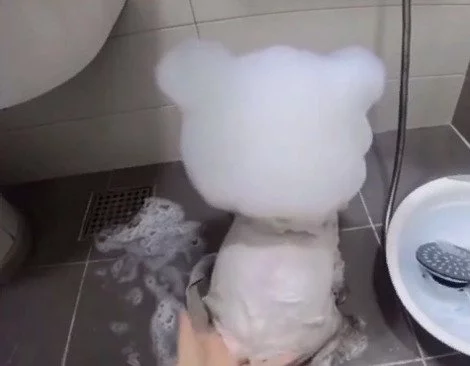Following the rules of hygiene of the pet is a guarantee of its health. Despite the fact that cats are among the cleanest animals, it is necessary to periodically perform water procedures.
It is most important to wash the cat if it has access to the outdoors. The hair gets dusty during walks, and the pet can also catch something through tainted food, dirt and contact with other animals.
When to bathe a cat
Cats themselves are clean animals, but despite this experts recommend washing them in the case of
- severe soiling, for example, after a walk outside;
- Creeping tangles;
- Dulling and loss of luster of the coat;
- treatment of various parasitic and infectious diseases, as well as allergic reactions with specialized products;
- participation in the exhibition – we bathe the animal with professional cosmetics to make the coat shiny and thick;
- scheduled haircuts at the groomer;
- if for any reason the animal has to go to the toilet in diapers, the procedure should be approached carefully, as bathing may worsen the current disease, so you should consult your veterinarian before the procedure.
It is worth bearing in mind that many cats have a fear of water. And this is quite natural. Not counting the fact that a wet cat is cold, in this form it is completely helpless, its scent is distinct, and therefore can be attacked by enemies, because the cat is a real predator. To accustom the animal to bathing, experts recommend the first one at an early age. An adult pet is more difficult to accustom to water. In addition, it is important to create a comfortable environment: exclude loud noises, do everything gradually. After for perseverance, it is worth offering the cat a treat, a toy.
How often you can wash a kitten and a cat
Kittens up to a year old should not be washed often, no more than once a month. If the baby has had a bad day and he got dirty, wash only the dirty place, be it paws, bottom, etc. Simply wipe the rest of the coat with a damp sponge if necessary.
An adult cat should not be washed unnecessarily more than once every three months during the cold season (i.e. once in the fall and winter at most), in spring and summer you can wash a total of four times. However, you should take into account that the number of water procedures depends on the breed of animal (length of hair), living conditions, environment. So, cats without fur bathed much more often than long- or short-haired cats, namely once every two weeks in summer and once a month in winter. Pets are bathed more often if they live in large cities, near highways or in environmentally disadvantaged areas.
When to bathe a kitten for the first time
If you bought a kitten, you do not need to run right away to bathe him. Moving to a new home and a stress for the baby, and here you are with your showers and shampoos. It is better to leave him alone for a few months. But if a kitten is found in the street you should not only wash it, but also treat it for external parasites, worms, take it to the vet.
If the kitten is less than three months old he should only be combed out, you can wipe with a wet sponge. If the kitten is a pedigree cat, and you plan to participate in exhibitions, you can start bathing at 3-4 months of age. In this case it is important to start early, because show class animals should be used to all kinds of procedures, they have to live with them.
What you need to know when first bathing a kitten
So, the rules of the first bath:
- The kitten must be awake and cheerful.
- Not hungry, but also not just eaten.
- The room should be warm.
In which cases bathing should be avoided:
- Less than two weeks have passed after vaccinations or treatment for external parasites.
- Recently neutered or spayed, it is best not to bathe the cat for at least two more months.
- If there is a large amount of discharge from the ears or eyes.
You should not wake the baby and immediately dunk him in the tub. Play with him first, he should be awake.

How to prepare the cat for a bath
Before carrying out the procedure, you need to prepare the working space: put shampoo and a large terry towel in close proximity. You should also set a comfortable water temperature – about 39 degrees. On no account should you wash your pet in cold or hot water.
In order to decrease the noise produced by the water, you should first draw a small amount of water in the tub and reduce the shower head, this way the cat will be less stressed and will tolerate the bathing better. The ideal is to eliminate the use of showers. You should prepare a sufficient amount of warm water and a ladle or a small pot with which to pour water over the cat.
About one day before the scheduled bath, it is recommended that the cat be thoroughly combed out so that no lumps or tangles will form when the water hits.
If it is the cat’s first bath, the cat should be reassured to avoid loud noises and screams that may frighten her. It is also recommended that two people do the procedure – one person holds, the other washes.
It is recommended to put a rubber mat or a terry towel on the bottom of the bath to prevent the cat from slipping on it.
Before putting the cat in the bath, shampoo is poured into a specially allocated container and diluted in water to form an abundant foam.
5 simple steps, how to wash a cat and what to do if he is afraid of water

- The first step is to place the animal in the bathtub, pour a small amount of warm water, while massaging the back, abdominal area, head. It is important to make sure that the water does not get into the eyes, nose and ears.
- Next, shampoo the hair and gently massage the lather, rubbing it in. Particular attention is paid to paws, belly and back. The muzzle is washed with a small sponge. Do not allow the detergent to get into the eyes, nose and ears.
- Then the shampoo is rinsed off. Warm water is poured over the whole cat. You can use the shower if the shampoo does not rinse out well. There should not be any remnants of the product on the coat, it causes dryness, dandruff formation. In addition, the pet will then lick it off, which is also not good.
- After the hair is wiped with a terry towel. You can use a hair dryer, if the cat is not afraid of it, but only with cold air, not hot.
- The final step is to brush the cat to prevent the formation of tangles.
It is interesting that cats, for the most part, are great swimmers. And some breeds even love to bathe. For example, the Turkish Van.
What products to bathe a cat?
In order not to harm the condition of the coat and skin of the pet, it is necessary to choose the right shampoo.
- Shampoos come in oily and dry skin. In the latter case, they reduce the formation of static, give shine, and nourish. Some tools are composed of sebum, that is a fat-like substance that is secreted by the sebaceous glands, as a result of which the coat is covered with a protective layer. If the pet has oily skin, the shampoo helps remove the greasy excess.
- If the pet has an untidy coat, a shampoo for eliminating tangles should be chosen. The mechanism of action is that the positively charged components come into contact with negatively charged hair strands, as a result of which the lumps are untangled. It also gives the coat a healthy shine and resilience.
- Tinting shampoo is usually used in preparation for a show to give the coat a distinct shine and deepen the color. Such products contain coloring pigments, which do not react with hair and are gradually washed out from the coat of a pet. The use of such shampoos is not recommended for bathing spotted cats, as the white areas of the coat may lose their color.
- A bleaching agent is used to bleach stains. It is most often used before a show.
- Special shampoo for breeds that do not have fur is designed for quality skin care. Such products are available in small quantities on the domestic market, and also have a high cost, so it is possible to replace it with a child’s hypoallergenic shampoo.
- Specialized treating shampoos are prescribed by a veterinarian to treat skin infections, treatment against fleas and lice.
Spray or dry shampoos have been created for cats who don’t like to wash at all. It is enough to spray them on the hair, and after a few minutes comb it.
Cat bathing products are used according to the instructions, in case of side effects or if the contents get into the eyes, ears or nose, you should consult a veterinarian.
Peculiarities of washing different breeds
Sphynxes do not have fur, which makes their skin prone to excessive fat production, so it is recommended that cats of this breed be bathed more often than others – from 7-9 times a year to once every 2-6 weeks. Between baths, you can wipe the skin with moist, hypoallergenic wipes.
You can tell if a bald cat needs to be bathed already by the following signs:
- an unpleasant odor;
- greasy buildup on the skin, stickiness;
- Dirt in the folds.
Long-haired and semi-long-haired breeds require less frequent bathing. For example, Persians and Siberians are bathed once every 1.5-2 months, or even less often. At the same time, it is recommended to use shampoo depending on your skin type, as well as conditioner to prevent the formation of tangles.
Short-haired cats, such as British, Scottish, Bengal, etc. do not need to be bathed at all, and in general, it is better to do it without an urgent need no more often than every 4-6 months.





